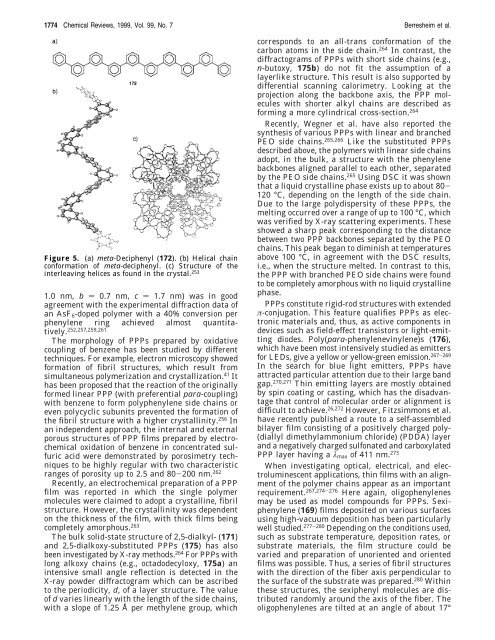Polyphenylene Nanostructures - Cluster for Molecular Chemistry
Polyphenylene Nanostructures - Cluster for Molecular Chemistry
Polyphenylene Nanostructures - Cluster for Molecular Chemistry
You also want an ePaper? Increase the reach of your titles
YUMPU automatically turns print PDFs into web optimized ePapers that Google loves.
1774 Chemical Reviews, 1999, Vol. 99, No. 7 Berresheim et al.<br />
Figure 5. (a) meta-Deciphenyl (172). (b) Helical chain<br />
con<strong>for</strong>mation of meta-deciphenyl. (c) Structure of the<br />
interleaving helices as found in the crystal. 253<br />
1.0 nm, b ) 0.7 nm, c ) 1.7 nm) was in good<br />
agreement with the experimental diffraction data of<br />
an AsF6-doped polymer with a 40% conversion per<br />
phenylene ring achieved almost quantitatively.<br />
252,257,259,261<br />
The morphology of PPPs prepared by oxidative<br />
coupling of benzene has been studied by different<br />
techniques. For example, electron microscopy showed<br />
<strong>for</strong>mation of fibril structures, which result from<br />
simultaneous polymerization and crystallization. 41 It<br />
has been proposed that the reaction of the originally<br />
<strong>for</strong>med linear PPP (with preferential para-coupling)<br />
with benzene to <strong>for</strong>m polyphenylene side chains or<br />
even polycyclic subunits prevented the <strong>for</strong>mation of<br />
the fibril structure with a higher crystallinity. 256 In<br />
an independent approach, the internal and external<br />
porous structures of PPP films prepared by electrochemical<br />
oxidation of benzene in concentrated sulfuric<br />
acid were demonstrated by porosimetry techniques<br />
to be highly regular with two characteristic<br />
ranges of porosity up to 2.5 and 80-200 nm. 262<br />
Recently, an electrochemical preparation of a PPP<br />
film was reported in which the single polymer<br />
molecules were claimed to adopt a crystalline, fibril<br />
structure. However, the crystallinity was dependent<br />
on the thickness of the film, with thick films being<br />
completely amorphous. 263<br />
The bulk solid-state structure of 2,5-dialkyl- (171)<br />
and 2,5-dialkoxy-substituted PPPs (175) has also<br />
been investigated by X-ray methods. 264 For PPPs with<br />
long alkoxy chains (e.g., octadodecyloxy, 175a) an<br />
intensive small angle reflection is detected in the<br />
X-ray powder diffractogram which can be ascribed<br />
to the periodicity, d, of a layer structure. The value<br />
of d varies linearly with the length of the side chains,<br />
with a slope of 1.25 Å per methylene group, which<br />
corresponds to an all-trans con<strong>for</strong>mation of the<br />
carbon atoms in the side chain. 264 In contrast, the<br />
diffractograms of PPPs with short side chains (e.g.,<br />
n-butoxy, 175b) do not fit the assumption of a<br />
layerlike structure. This result is also supported by<br />
differential scanning calorimetry. Looking at the<br />
projection along the backbone axis, the PPP molecules<br />
with shorter alkyl chains are described as<br />
<strong>for</strong>ming a more cylindrical cross-section. 264<br />
Recently, Wegner et al. have also reported the<br />
synthesis of various PPPs with linear and branched<br />
PEO side chains. 265,266 Like the substituted PPPs<br />
described above, the polymers with linear side chains<br />
adopt, in the bulk, a structure with the phenylene<br />
backbones aligned parallel to each other, separated<br />
by the PEO side chains. 265 Using DSC it was shown<br />
that a liquid crystalline phase exists up to about 80-<br />
120 °C, depending on the length of the side chain.<br />
Due to the large polydispersity of these PPPs, the<br />
melting occurred over a range of up to 100 °C, which<br />
was verified by X-ray scattering experiments. These<br />
showed a sharp peak corresponding to the distance<br />
between two PPP backbones separated by the PEO<br />
chains. This peak began to diminish at temperatures<br />
above 100 °C, in agreement with the DSC results,<br />
i.e., when the structure melted. In contrast to this,<br />
the PPP with branched PEO side chains were found<br />
to be completely amorphous with no liquid crystalline<br />
phase.<br />
PPPs constitute rigid-rod structures with extended<br />
π-conjugation. This feature qualifies PPPs as electronic<br />
materials and, thus, as active components in<br />
devices such as field-effect transistors or light-emitting<br />
diodes. Poly(para-phenylenevinylene)s (176),<br />
which have been most intensively studied as emitters<br />
<strong>for</strong> LEDs, give a yellow or yellow-green emission. 267-269<br />
In the search <strong>for</strong> blue light emitters, PPPs have<br />
attracted particular attention due to their large band<br />
gap. 270,271 Thin emitting layers are mostly obtained<br />
by spin coating or casting, which has the disadvantage<br />
that control of molecular order or alignment is<br />
difficult to achieve. 26,272 However, Fitzsimmons et al.<br />
have recently published a route to a self-assembled<br />
bilayer film consisting of a positively charged poly-<br />
(diallyl dimethylammonium chloride) (PDDA) layer<br />
and a negatively charged sulfonated and carboxylated<br />
PPP layer having a λmax of 411 nm. 273<br />
When investigating optical, electrical, and electroluminescent<br />
applications, thin films with an alignment<br />
of the polymer chains appear as an important<br />
requirement. 267,274-276 Here again, oligophenylenes<br />
may be used as model compounds <strong>for</strong> PPPs. Sexiphenylene<br />
(169) films deposited on various surfaces<br />
using high-vacuum deposition has been particularly<br />
well studied. 277-280 Depending on the conditions used,<br />
such as substrate temperature, deposition rates, or<br />
substrate materials, the film structure could be<br />
varied and preparation of unoriented and oriented<br />
films was possible. Thus, a series of fibril structures<br />
with the direction of the fiber axis perpendicular to<br />
the surface of the substrate was prepared. 280 Within<br />
these structures, the sexiphenyl molecules are distributed<br />
randomly around the axis of the fiber. The<br />
oligophenylenes are tilted at an angle of about 17°

















